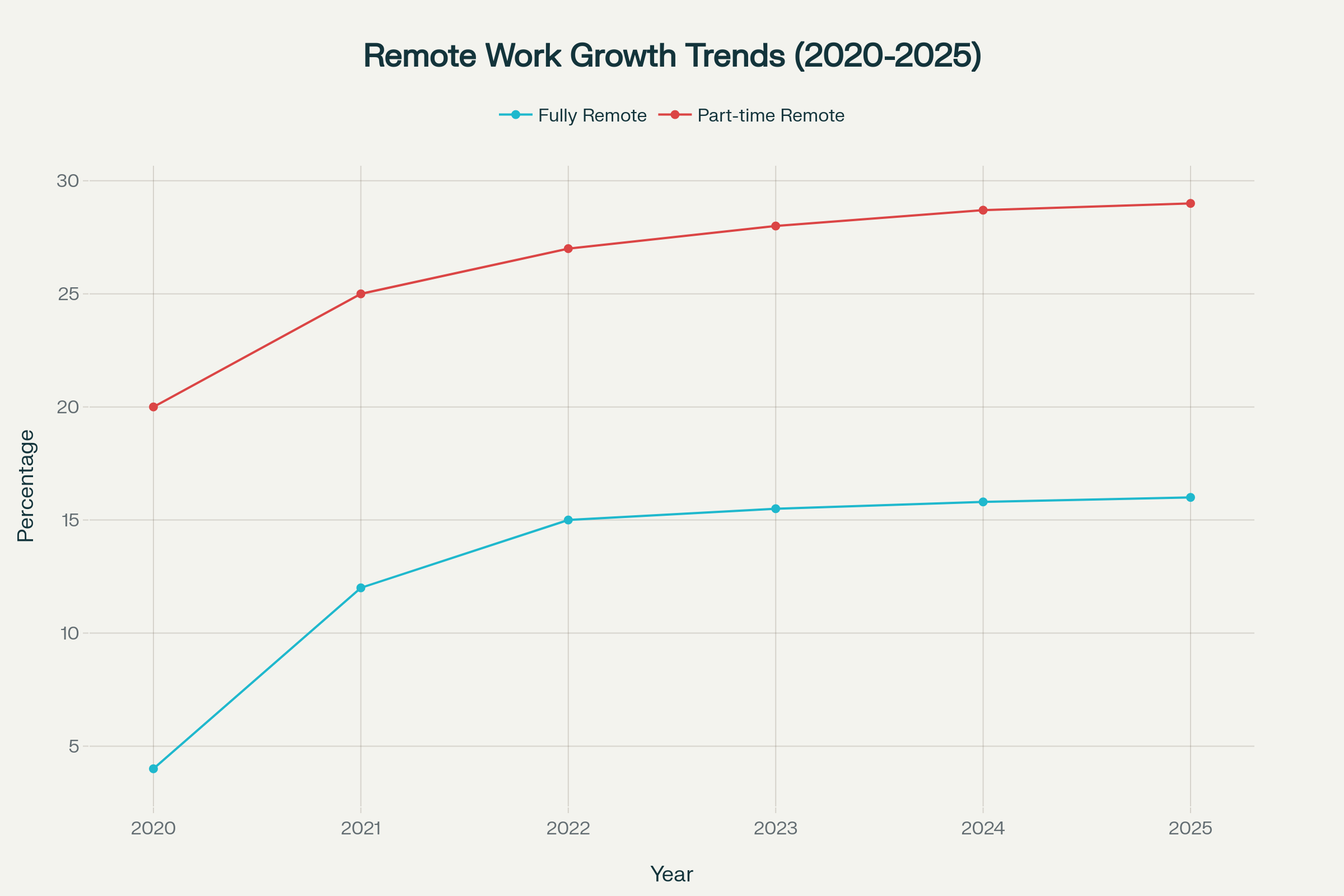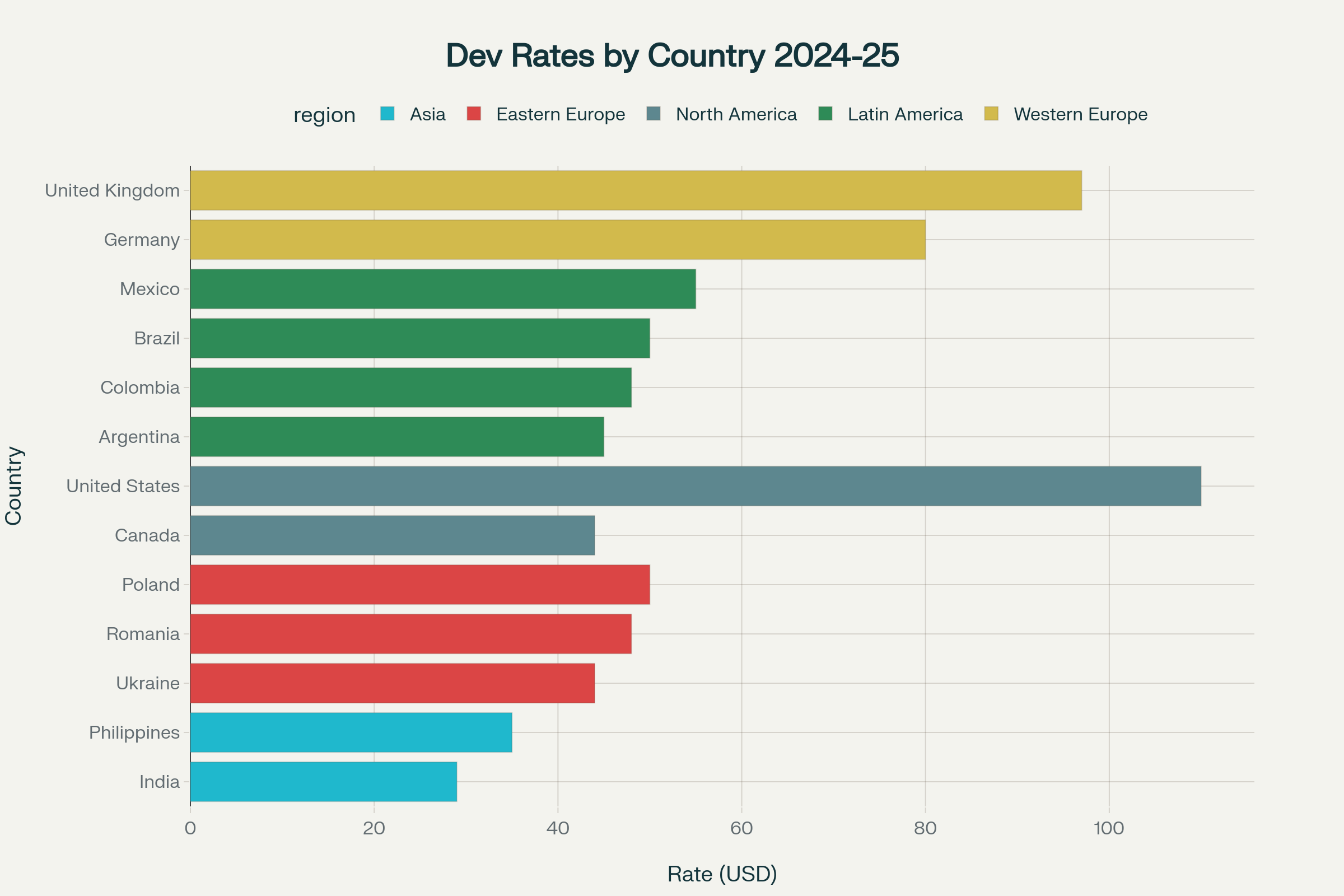The global shift toward remote work has fundamentally transformed how companies source and manage talent. With 28.7% of the workforce now working remotely and remote job postings stabilizing at 15-16% of all opportunities, hire remote developers has become not just an option, but a strategic necessity for businesses seeking competitive advantage. This comprehensive guide provides expert insights into hiring remote developers both in India and internationally, covering everything from cost optimization to legal compliance.getaura+1

Growth trajectory of remote work opportunities and remote workforce participation from 2020 to 2025, showing stabilization after initial pandemic-driven growth
Understanding the Remote Developer Hiring Landscape
The Current State of Remote Development Work
Remote work has evolved from a pandemic-driven necessity to a permanent fixture in the tech industry. Recent data shows that 69% of US companies now offer work location flexibility, up from 51% in 2024. The technology sector leads this transformation, with 54% of new tech job postings being remote or hybrid roles.index+1
The numbers tell a compelling story: 5.8 million remote jobs were posted in 2024, and despite a 20.5% decline from peak pandemic levels, remote opportunities have stabilized at sustainable levels. For software developers specifically, this represents unprecedented access to global talent pools and employment opportunities.getaura
Why Remote Developer Hiring Matters
The global software developer shortage is driving the remote hiring boom. With 85.2 million IT positions projected to remain unfilled by 2030, companies face an urgent need to expand their talent acquisition strategies beyond local markets. Current statistics reveal:innoloft
- 1.4 million developer shortage in 2021, projected to reach 4.0 million by 2025bairesdev
- 61% of HR professionals struggle to recruit qualified developer talentbairesdev
- It takes an average of 66 days and $20,000 to hire a software developer in-housealcor-bpo
These challenges make remote hiring not just attractive, but essential for business continuity and growth.
Top Destinations for Hiring Remote Developers
India: The Global Development Powerhouse
India remains the most popular destination for remote developer hiring, and for good reason. The country boasts 5.8 million developers with 1.5 million engineering graduates entering the market annually. This massive talent pool offers several advantages:ellow
Cost Advantages: Indian developers typically charge $18-40 per hour, representing significant savings compared to Western markets. This cost efficiency doesn’t compromise quality – many Indian developers possess strong technical skills and excellent English proficiency.acquaintsoft+1
Technical Expertise: Indian developers excel across various technologies, from traditional web development to cutting-edge AI and machine learning. The country’s strong educational infrastructure produces developers skilled in:
- Full-stack development (React, Node.js, Python, Java)
- Mobile development (iOS, Android, Flutter, React Native)
- Cloud technologies (AWS, Azure, Google Cloud)
- Emerging technologies (AI/ML, blockchain, DevOps)
Time Zone Benefits: India’s time zone allows for overlap with both European and Asian markets, enabling real-time collaboration during business hours.

A modern remote developer’s home workspace with dual monitors, ergonomic setup, and ambient lighting makerstations
Other High-Value Destinations
Eastern Europe offers a compelling middle ground with rates typically ranging $38-50 per hour. Countries like Ukraine, Poland, and Romania provide:
- Strong technical education systems
- High English proficiency
- Cultural alignment with Western business practices
- Favorable time zone overlap with European clients
Latin America has emerged as a preferred choice for US companies, with developers charging $35-65 per hour depending on the country. Key advantages include:index
- Minimal time zone differences with North American clients
- Growing tech ecosystems in countries like Brazil, Mexico, and Argentina
- Increasing government support for tech education and development
Southeast Asia offers competitive rates similar to India, with the Philippines leading at $20-49 per hour. The region provides:upstackstudio
- Strong English language skills, particularly in the Philippines
- Growing technical capabilities
- Cultural adaptability to international business practices

Comparison of remote developer hourly rates across different countries and regions, showing significant cost advantages in Asia and Latin America
Legal Considerations and Compliance
Understanding Employment Classifications
One of the most critical aspects of hiring remote developers internationally involves proper worker classification. Misclassifying employees as contractors can result in significant penalties and legal complications.worktually
Employee vs. Contractor Determination: Each country has specific criteria for employment classification:
- Control over work: Does the company direct how, when, and where work is performed?
- Financial aspects: Who provides tools, equipment, and covers business expenses?
- Relationship permanency: Is this an ongoing relationship or project-based work?
Legal Implications: Misclassification can lead to:
- Back payment of taxes and benefits
- Fines and penalties (up to €20 million under GDPR for data violations)
- Legal disputes and reputational damage
Tax and Compliance Requirements
International remote hiring creates complex tax obligations that vary by jurisdiction. Key considerations include:worktually+1
Tax Treaties: Many countries have agreements preventing double taxation. For example, Canada has tax treaties with over 90 countries, defining where income is taxed.worktually
Local Labor Laws: Each country maintains specific regulations regarding:
- Minimum wages and working hours
- Mandatory benefits and social contributions
- Termination procedures and severance requirements
- Data privacy and protection standards
Employer of Record (EOR) Solutions
EOR services have emerged as the preferred solution for companies wanting to hire internationally without establishing local entities. Leading providers like Remote, Deel, and specialized India-focused services offer:remote+1
Core Services:
- Legal employment on behalf of your company
- Payroll processing and tax compliance
- Benefits administration
- Contract management
- Local HR support
Cost Structure: Most EOR services charge $599-699 per employee per month, significantly less than establishing a local entity.remote
Benefits:
- Faster market entry – hire within days rather than months
- Full compliance with local employment laws
- Reduced legal risk and administrative burden
- Access to local benefits and competitive packages
Technical Assessment and Hiring Process
Developing Effective Assessment Strategies
Technical assessment is crucial for remote hiring success, with 73% of technical hires showing performance discrepancies from their interview performance. A comprehensive assessment framework should include:fullscale
Multi-Stage Evaluation Process:
- Initial Screening: Automated assessments for fundamental skills
- Technical Deep-Dive: Live coding sessions or take-home projects
- Cultural Fit Assessment: Communication skills and remote work readiness
- Final Evaluation: System design or architecture discussions
Assessment Methods and Best Practices
Live Coding Interviews: Real-time problem-solving sessions that reveal:
- Technical competency and coding practices
- Communication skills and thought processes
- Ability to work under pressure
- Collaboration potential
Best Practices for Remote Interviews:
- Use collaborative coding platforms (CoderPad, Codility Live)
- Provide clear preparation guidelines
- Include warm-up problems to reduce anxiety
- Focus on problem-solving approach over perfect solutions
Take-Home Projects: Structured assignments (3-4 hours maximum) that demonstrate:
- Real-world problem-solving capabilities
- Code quality and documentation skills
- Time management and project organization
- Technical decision-making abilities
Tools and Platforms: Leading assessment platforms include:
- HackerRank: Comprehensive skill evaluation and automated screening
- Codility: Advanced coding assessments with plagiarism detection
- GitHub: Portfolio evaluation and code review capabilities
- DevSkiller: Real-world coding tests and technical interviews

A professional engages in a virtual video call with a diverse remote team, illustrating remote collaboration and communication asaporg
Remote Work Readiness Assessment
Beyond technical skills, evaluating remote work capabilities is essential:
Communication Assessment:
- Written communication clarity and professionalism
- Ability to explain technical concepts to non-technical stakeholders
- Responsiveness and availability during specified hours
Self-Management Evaluation:
- Experience with remote work tools and methodologies
- Time zone flexibility and schedule management
- Independent problem-solving capabilities
- Proactive communication and status reporting
Cost Analysis and Budget Planning
Understanding Total Compensation Costs
While hourly rates provide a baseline, total cost of hiring includes several additional factors:
Direct Costs:
- Base salary or hourly rate
- Benefits and social contributions
- Equipment and software licenses
- Training and onboarding expenses
Indirect Costs:
- Recruitment and assessment time
- Management and communication overhead
- Legal and compliance expenses
- Currency fluctuation risks
Regional Cost Comparison
Based on comprehensive market research, here’s a detailed breakdown of developer costs by region:index+2
Asia Pacific:
- India: $18-40/hour (junior to senior developers)
- Philippines: $20-49/hour
- Vietnam: $25-45/hour
Eastern Europe:
- Ukraine: $38-50/hour
- Poland: $45-55/hour
- Romania: $40-50/hour
Latin America:
- Brazil: $40-60/hour
- Mexico: $45-65/hour
- Argentina: $35-55/hour
Western Markets:
- United States: $70-150/hour
- Canada: $36-52/hour
- United Kingdom: $90-100/hour
Calculating ROI and Value Proposition
The cost savings from remote hiring can be substantial:
- 30-50% cost reduction compared to local US/European hiring
- Reduced overhead costs (office space, equipment, utilities)
- Access to specialized skills not available locally
- 24/7 development cycles with strategic time zone distribution
Managing Remote Development Teams
Communication and Collaboration Tools
Successful remote teams rely on sophisticated tool stacks that facilitate both synchronous and asynchronous collaboration. Essential categories include:mismo
Communication Platforms:
- Slack/Microsoft Teams: Organized messaging with channel structure
- Zoom/Google Meet: Video conferencing with screen sharing
- Asynchronous communication: Clear protocols for non-real-time updates
Project Management Systems:
- Jira: Agile project management and bug tracking
- Trello/Asana: Task management and workflow visualization
- GitHub/GitLab: Version control and code collaboration
Development Tools:
- Integrated Development Environments: Collaborative coding platforms
- CI/CD Pipelines: Automated testing and deployment
- Documentation Systems: Confluence, Notion for knowledge sharing
Team Management Best Practices
Establishing Clear Expectations:
- Define roles, responsibilities, and deliverables
- Set communication protocols and availability windows
- Create detailed project documentation and requirements
- Establish regular check-in schedules and reporting structures
Performance Monitoring:
- Use KPIs and OKRs aligned with project goals
- Implement time tracking tools (Toggl, Clockify) for productivity insights
- Conduct regular code reviews and quality assessments
- Provide continuous feedback and professional development opportunities
Cultural Integration:
- Organize virtual team-building activities
- Respect cultural differences and local holidays
- Create inclusive meeting schedules across time zones
- Foster knowledge sharing and mentorship programs
Agile Methodology Implementation
Remote Scrum Practices:
- Daily stand-ups via video conference
- Sprint planning with collaborative estimation
- Virtual retrospectives for continuous improvement
- Distributed pair programming sessions
DevOps Culture:
- Automated testing and continuous integration
- Shared responsibility for deployment and monitoring
- Cross-functional collaboration between development and operations
- Emphasis on reliability and system performance
Platform and Sourcing Strategies
Popular Hiring Platforms
Freelance Platforms:
- Toptal: Accesses top 3% of global talent with rigorous screening
- Upwork: Large talent pool with varied skill levels and pricing
- Arc: Focuses on pre-vetted remote developers and technical talent
Development Agencies:
- DevTeam.Space: Provides dedicated development teams with project management
- ValueCoders: Offers cost-effective offshore development services
- Classic Informatics: Specializes in web and mobile development
Specialized Platforms:
- Stack Overflow Jobs: Targets experienced developers with strong technical backgrounds
- GitHub Jobs: Connects with developers through their code contributions
- AngelList: Focuses on startup-friendly talent and equity-based compensation

Laptop screen showing code in a development environment, representing remote software development work remotehabits
Sourcing Strategy Optimization
Multi-Channel Approach:
- Combine direct recruitment with platform sourcing
- Leverage professional networks and referrals
- Partner with specialized technical recruitment agencies
- Utilize social media and developer communities
Talent Pipeline Development:
- Build relationships with coding bootcamps and universities
- Maintain candidate databases for future opportunities
- Create employer branding that attracts remote talent
- Offer internship and training programs for skill development
Challenges and Solutions
Common Remote Hiring Challenges
Communication Barriers:
- Time zone coordination difficulties
- Language and cultural misunderstandings
- Lack of face-to-face interaction
- Reduced spontaneous collaboration
Solutions:
- Establish overlapping work hours for real-time collaboration
- Use asynchronous communication for non-urgent matters
- Provide cultural sensitivity training for all team members
- Create structured communication protocols and escalation procedures
Quality Control and Monitoring:
- Difficulty assessing actual work output
- Ensuring code quality and standards compliance
- Managing project timelines and deliverables
- Maintaining security and intellectual property protection
Solutions:
- Implement comprehensive code review processes
- Use automated testing and quality assurance tools
- Establish clear performance metrics and reporting systems
- Create secure development environments and access controls
Building Trust and Accountability
Transparency Measures:
- Regular progress updates and status reports
- Shared dashboards for project visibility
- Open communication about challenges and blockers
- Collaborative problem-solving approaches
Performance Management:
- Set clear, measurable objectives and deadlines
- Provide regular feedback and recognition
- Create career development pathways for remote team members
- Implement fair and consistent evaluation processes
Future of Remote Developer Hiring
Emerging Trends
AI-Enhanced Recruitment: Artificial intelligence is revolutionizing technical assessment and candidate matching, with 87% of organizations now using AI in their hiring processes.linkedin
Hybrid Work Models: Companies are developing sophisticated approaches combining remote and in-office work, with 52% of employees preferring hybrid arrangements.invedus
Global Talent Equalization: Geographic barriers continue to diminish as technology improves, creating truly global talent markets where exceptional developers can thrive regardless of location.index
Technology Evolution
Advanced Collaboration Tools: Next-generation platforms promise to capture the spontaneous creativity of in-person work while preserving the deep focus of remote environments.index
Security and Compliance: Improved tools for managing distributed team security and ensuring regulatory compliance across multiple jurisdictions.
Performance Analytics: Enhanced systems for measuring and optimizing remote team productivity and engagement.
Key Takeaways and Recommendations
Strategic Recommendations
- Start with Clear Objectives: Define your technical requirements, budget constraints, and timeline expectations before beginning the hiring process.
- Invest in Proper Assessment: Develop comprehensive evaluation frameworks that test both technical competency and remote work readiness.
- Choose the Right Legal Structure: Consider EOR services for quick market entry or direct employment for long-term strategic hires.
- Build Strong Management Systems: Implement robust communication tools, project management processes, and performance monitoring systems.
- Focus on Cultural Integration: Create inclusive environments that bridge geographical and cultural gaps between team members.
Best Practices Summary
- Budget for total cost of hiring, not just hourly rates
- Prioritize communication skills alongside technical capabilities
- Establish clear legal compliance frameworks from the start
- Invest in quality management tools and processes
- Create structured onboarding programs for remote team members
- Build long-term relationships rather than viewing remote hiring as purely transactional
The remote developer hiring landscape continues to evolve rapidly, offering unprecedented opportunities for businesses to access global talent while achieving significant cost efficiencies. Success requires strategic planning, proper legal foundation, and commitment to building inclusive, productive remote teams. Companies that master these elements will gain competitive advantages in the global marketplace while building resilient, scalable development organizations.
By following the comprehensive strategies outlined in this guide, businesses can confidently navigate the complexities of international remote hiring and build world-class development teams that drive innovation and growth in the digital economy.





